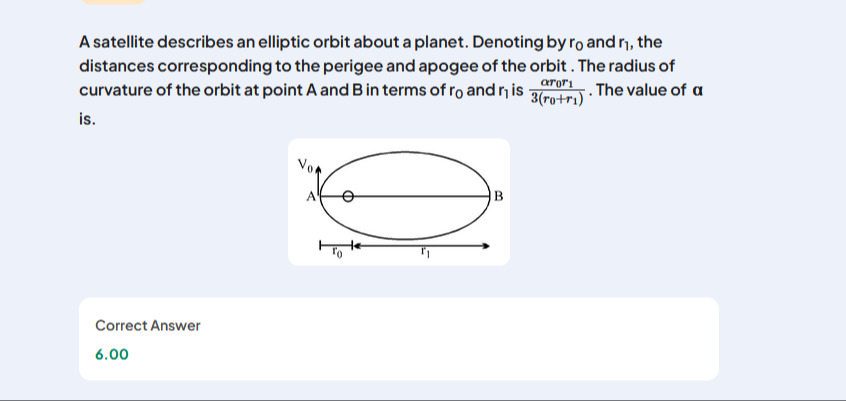Question
Question: A satellite describes an elliptic orbit about a planet. Denoting by $r_0$ and $r_1$, the distances c...
A satellite describes an elliptic orbit about a planet. Denoting by r0 and r1, the distances corresponding to the perigee and apogee of the orbit. The radius of curvature of the orbit at point A and B in terms of r0 and r1 is 3(r0+r1)αr0r1. The value of α is.

6.00
Solution
The radius of curvature of an ellipse at the vertices of the major axis (perigee and apogee in this case, as the planet is at a focus) is given by ρ=ab2, where a is the semi-major axis and b is the semi-minor axis of the ellipse.
Let r0 be the distance at perigee (point A) and r1 be the distance at apogee (point B).
For an elliptical orbit with the focus at the origin, the perigee distance is r0=a(1−e) and the apogee distance is r1=a(1+e), where e is the eccentricity.
Adding these two equations gives r0+r1=2a, so the semi-major axis is a=2r0+r1.
The distance from the center to the focus is c=ae. From r1−r0=2ae, we get e=2ar1−r0=r0+r1r1−r0.
The relationship between a, b, and e is b2=a2(1−e2).
b2=a2(1−e)(1+e)=(a(1−e))(a(1+e))=r0r1.
So, the square of the semi-minor axis is b2=r0r1.
The radius of curvature at the perigee and apogee is ρ=ab2.
Substituting the expressions for a and b2 in terms of r0 and r1:
ρ=(r0+r1)/2r0r1=r0+r12r0r1.
The question states that the radius of curvature of the orbit at point A and B is given by 3(r0+r1)αr0r1.
Comparing this with our derived expression:
r0+r12r0r1=3(r0+r1)αr0r1.
Assuming r0>0 and r1>0, we can cancel r0r1 and r0+r1 from both sides (since r0+r1>0).
2=3α.
Solving for α:
α=2×3=6.
